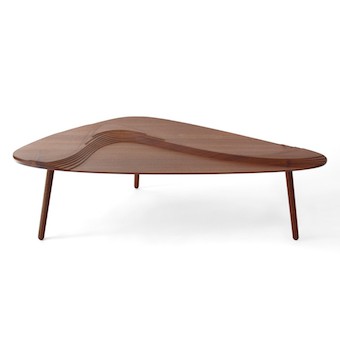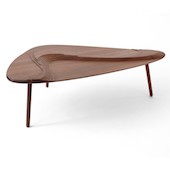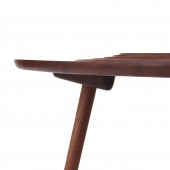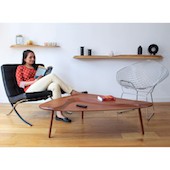
| THE AWARD |
| CATEGORIES |
| REGISTRATION |
| SUBMIT YOUR WORK |
| ENTRY INSTRUCTIONS |
| TERMS & CONDITIONS |
| PUBLICATIONS |
| DATES & FEES |
| METHODOLOGY |
| CONTACT |
| WINNERS |
| PRESS ROOM |
| GET INVOLVED |
| DESIGN PRIZE |
| DESIGN STORE |
| THE AWARD | JURY | CATEGORIES | REGISTRATION | PRESS | WINNERS | PUBLICATIONS | ENTRY INSTRUCTIONS |
Terrace Coffee Table by Hemal Patel |
Home > Winners > Design #69044 >Interview |
 |
|
FS: What is the main principle, idea and inspiration behind your design?
HP: The design of the Terrace coffee table is inspired by terrace farming practices employed in mountainous regions of the Far East and South America. In much the same way that the hillsides are terraformed to produce flat, cultivatable land, the terraces meandering across the table surface are carved out of the wood to form two large, flat plains which provide practical areas for work or storage.
FS: What has been your main focus in designing this work? Especially what did you want to achieve?
HP: Our focus was to design a table that is unique and interesting, both aesthetically and functionally. In particular, we wanted the table to change the way people perceive and interact with furniture. So, we used terraces and layers to break away from the traditional linear aesthetic of standard furniture, and introduce height and depth (in the form of platforms) as a means to escape the monotony of flat surfaces. Not only does this add character to the design, but it forces the user to rethink how each piece is to be used by offering a functionality that is unconventional yet familiar.
FS: What are your future plans for this award winning design?
HP: We hope to grow the range with a series of pieces with a similar aesthetic.
FS: How long did it take you to design this particular concept?
HP: The concept came about very quickly, but prototyping, testing and developing the piece into a mass-manufacturable item took about 6 months.
FS: Why did you design this particular concept? Was this design commissioned or did you decide to pursuit an inspiration?
HP: As we are a start-up we created this piece to showcase our capabilities to prospective clients, and to build our portfolio. At the time of conception the project was not commissioned, it was a purely speculative endeavour.
FS: Is your design being produced or used by another company, or do you plan to sell or lease the production rights or do you intent to produce your work yourself?
HP: Luckily, the item was picked up by a London-based brand called HeadSprung!, who are manufacturing and selling the piece.
FS: What made you design this particular type of work?
HP: We wanted to create a piece of furniture that is different and unique to other products on the market. In particular, we wanted to design something whose function is unconventional but intuitive, and whose aesthetic is beautiful yet original.
FS: Where there any other designs and/or designers that helped the influence the design of your work?
HP: No other designs or designers helped influence this work. Mother nature and the farmers and civilisations that cultivated terrace farming on hillsides were our influences.
FS: Who is the target customer for his design?
HP: Our target customers are interior designers and architects for both domestic and contract environments. We also hope to target the design savvy and those interested in art and sculpture.
FS: What sets this design apart from other similar or resembling concepts?
HP: There are three features that set this design apart from other concepts. First, the table’s sculptural form elevates it from just another piece of furniture to functional art. Second, the way light and shadow advance and retreat along the sweeping contours, as you walk around the table, accentuates the beauty of the carvings and imparts a dynamism rarely seen in furniture. Third and final, the terraces introduce height and depth to the design that helps escape the monotony of flat surfaces. These not only add character to the design, but they also force the user to rethink how the piece is to be used by offering a functionality that is unconventional yet familiar.
FS: How did you come up with the name for this design? What does it mean?
HP: Naming the table was easy as it refers to the terrace farming practices upon which the design is based.
FS: Which design tools did you use when you were working on this project?
HP: We used 3D modelling software to design the table, and then a 3-axis CNC router to prototype and manufacture the tabletop. The legs were made on a lathe. We also used specialist machinery to test the strength and durability of the table, to ensure longevity and fitness for purpose in domestic and contract environments.
FS: What is the most unique aspect of your design?
HP: The sculptural quality of the table is it’s most unique aspect. Most tables are flat and linear, but this table has 3-dimensional features that elevate it’s design from a mere table to functional art.
FS: Who did you collaborate with for this design? Did you work with people with technical / specialized skills?
HP: We worked with a joinery company on the finer details of the design, especially in developing the product to avoid warping (caused by material thickness variations), and in simplifying the design for scale-up in production.
FS: What is the role of technology in this particular design?
HP: Technology allowed us to model the table, and fabricate it in a quick, efficient and repeatable way. Without the use of 3D modelling software or automated machinery we would not be able to make this table in volume or at an accessible price point.
FS: Is your design influenced by data or analytical research in any way? What kind of research did you conduct for making this design?
HP: In the process of designing the table we researched terrace farming to better understand the practice better. We also undertook an image search of terrace farming in South America and the Far East to inform the aesthetics of the table.
FS: What are some of the challenges you faced during the design/realization of your concept?
HP: The biggest challenge we faced was to stop warping caused by the varying material thickness across the length of the table. Thankfully, we managed to control this issue by modifying the design, and including horizontal braces under the table to give strength and rigidity.
FS: How did you decide to submit your design to an international design competition?
HP: From the early reaction we received from the manufacturer and the public we realised we had a design that could be award worthy. This gave us confidence to submit the design to various design competitions.
FS: What did you learn or how did you improve yourself during the designing of this work?
HP: We learned more about the qualities and processing of wood, we learned about terrace farming, and we learned more about CNC technologies, capabilities and limitations. The project also helped to cement our resolve to work more closely with suppliers and clients, to bring to market better realised, more innovative products.
FS: Thank you for providing us with this opportunity to interview you.
A' Design Award and Competitions grants rights to press members and bloggers to use parts of this interview. This interview is provided as it is; DesignPRWire and A' Design Award and Competitions cannot be held responsible for the answers given by participating designers.
| SOCIAL |
| + Add to Likes / Favorites | Send to My Email | Comment | View Press-Release |





